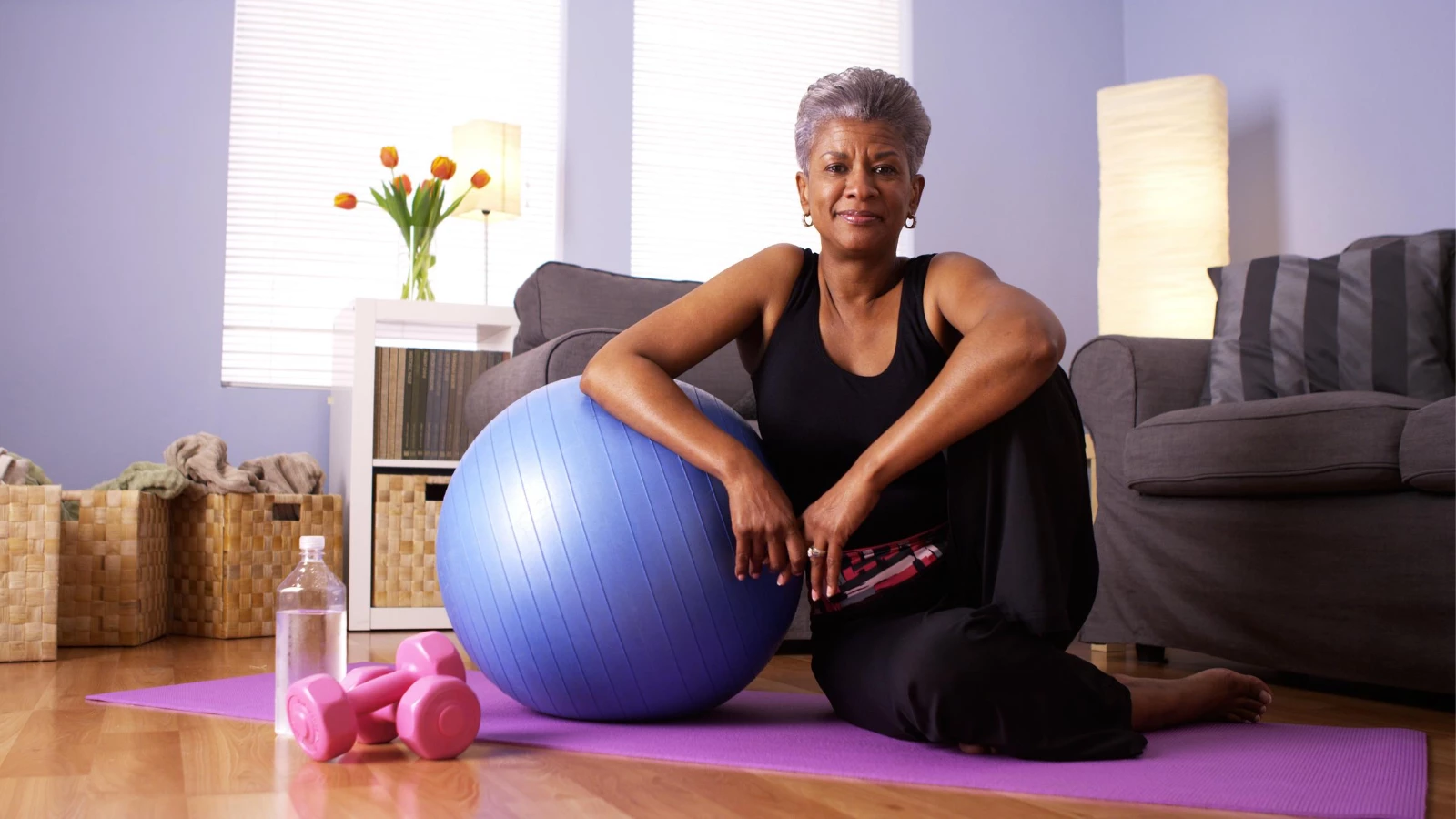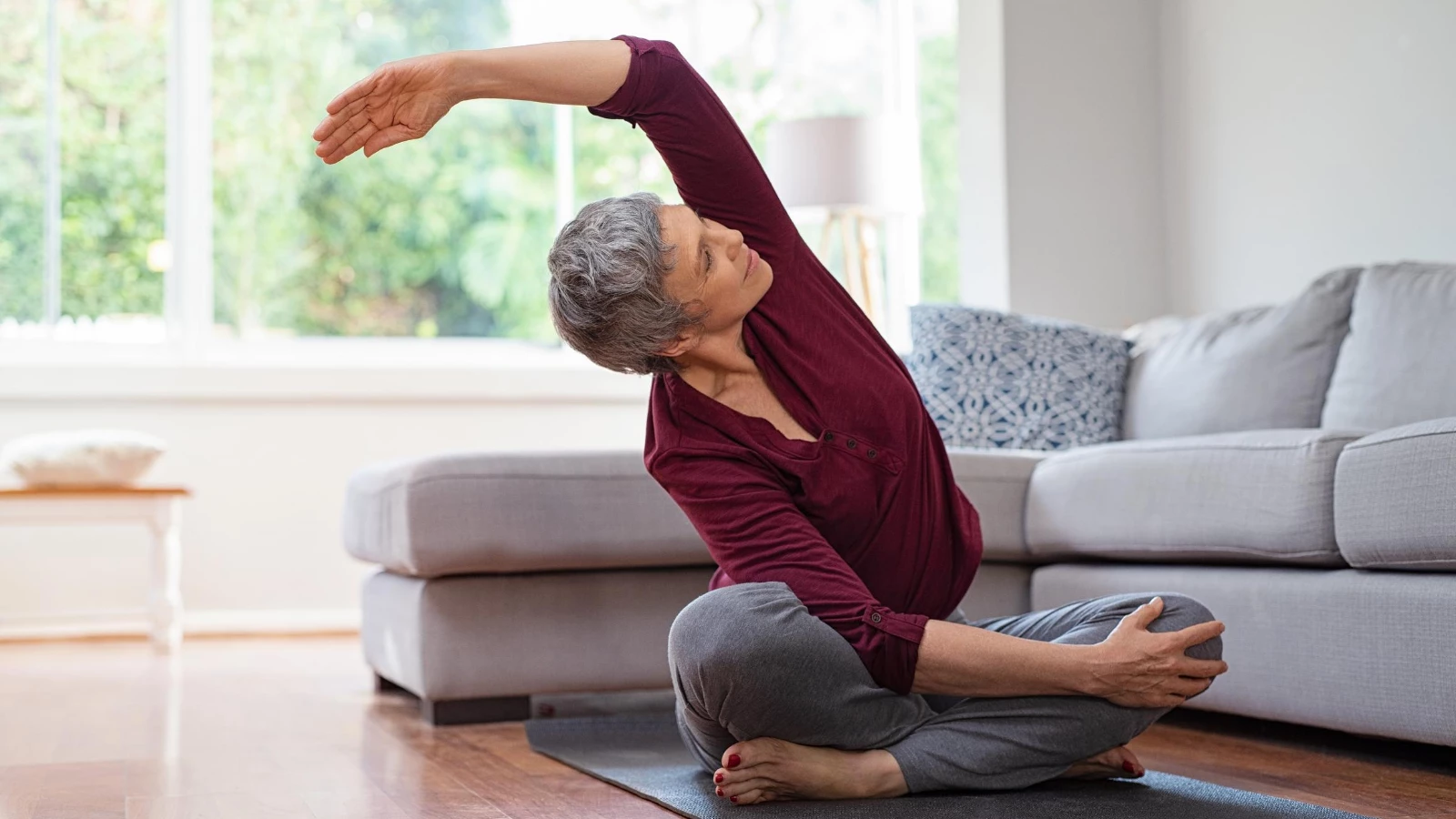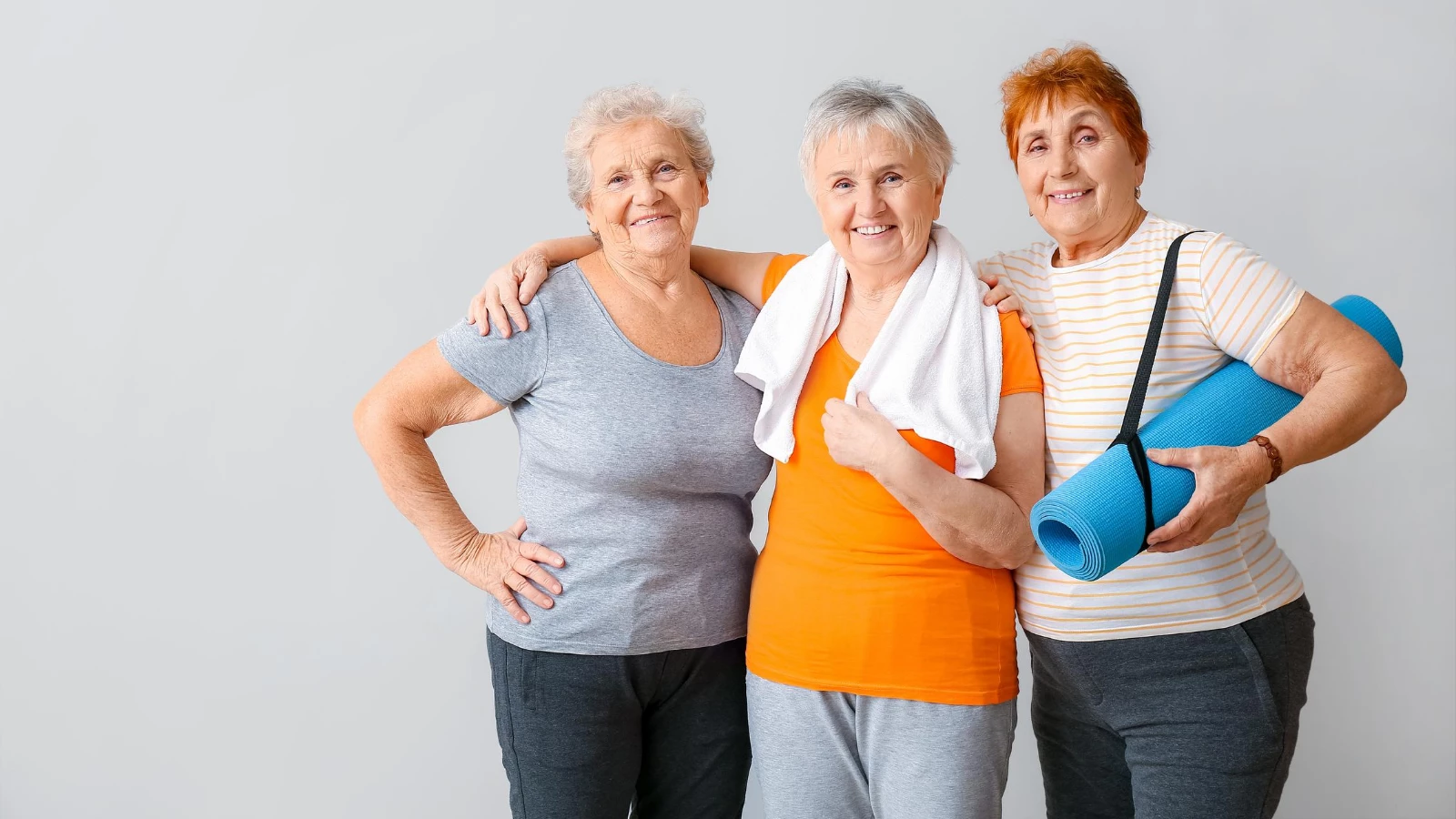Transforming Menopause: How Yoga Practice Can Support a Smooth Transition

Rather than seeing menopause just as the end of fertility and the start of aging, we can look at it as both a life transition and as a potentially transformative experience. Given our modern health care and longer life spans, women in First World countries can anticipate spending close to one-third of their lives in a post-reproductive state.
Dr. Christiane Northrup, the author of The Wisdom of Menopause, said, “The years surrounding menopause and encompassing the gradual change in ovarian function constitute an entire stage of a woman’s life, lasting from six to thirteen years.” Without reproductive and caretaking responsibilities, women can use more of their time for personal self-development, healing, and realization. And while this transition is often described as the “change of life” and freedom from social and culturally defined roles, each woman’s menopause experience is like a fingerprint—unique and personal. And the way each woman perceives and moves through this transition can transform her inner and outer experience.
Menopause and Yoga’s 4 Stages of Life

One way we can view this transition is through yoga philosophy, which says that there are four stages of life (ashramas): the student, the householder, the forest dweller, and the renunciate. As a student (or child), one learns about one’s role in society. As a householder (adult), one raises a family and/or contributes to society through relationships, work, or volunteer efforts. As a forest dweller (midlife), one begins the preparatory work for personal or spiritual realization, and may finally choose to become a renunciate and turn the final years into an opportunity for spiritual wisdom and enlightenment.
For women, the forest dweller stage seems perfectly timed to occur at about the same time you enter menopause, and your children, if you have any, leave home to begin lives of their own. This transition can be seen as a movement away from a more active (rajasic) time of life toward a more contemplative (sattvic) time of life.
Yogic Strategies for Negotiating the Menopause Process
Many Western writers and thinkers, such as Marian VanEyke McCain, Christiane Northrup, and Clarissa Pinkola Estes, support this yogic view of the female human life span. They point to the drive that moves women at this time to begin an inner journey, address unfinished business, and claim the wisdom and power inherent in this time of life. Seen from this perspective, the menopausal process is a natural transition that can lead to transformation.
While writing a master’s project on menopause, I spoke with and surveyed about 30 women about their menopause experiences. In addition, at that time, I worked in a small all-female office, and the three of us shared our experiences openly. In general, I found that women’s responses fell into three categories:
- Fix and forget
- Menopause as process
- Menopause as transformation

Fix and Forget: Many women I talked to perceived menopause and its symptoms as biological events to be fixed or forgotten. When D. talked about menopause, her conversation centered around which therapist she had last seen and what they had prescribed to fix her problems: one pill for headaches, birth control pills for irregular periods, and something else for mood swings. She told us that she wished for a hysterectomy to “get it all over with.” On the other hand, V. said, “I don’t remember attaching any great meaning to menopause. It came, it wasn’t difficult, it went, and I forgot about it in fairly short order.” Both women overlooked the opportunity to see menopause as a catalyst for healing and transformation.
Menopause as Process: Menopause often involves much more than physiological changes in the body. This is true even if women are not aware of all the multidimensional changes that may be taking place in their lives. This transition has amazing potential for causing change, as illustrated by the following comments from two women. One said, “It’s a change in my life, an aging process, but one I want to control.” The other responded, “I know I’m going to experience many changes, and I want to learn how to handle them, so I don’t feel so frustrated.”
Northrup calls menopause, “the mother of all wake-up calls,” our body’s way of letting us know the need to do inner work—to heal an experience, conflict or issue in our lives. The increased psychic energy available for this inner work is related to a woman’s fluctuating hormone levels. These alter the brain chemistry by sparking changes to the temporal lobes associated with enhanced intuition, the right brain hemisphere. Northrup states, “At midlife, the hormonal milieu that was present for only a few days each month during most of your productive years to spur you on to reexamine your life just a little at a time, now gets stuck in the on position for weeks or months at a time.”
K. recognized this. She was experiencing hot flashes and mental confusion, and told me that she no longer felt “normal.” Her doctors advised her to take estrogen, and seek counseling. But she was able to find some relief through yoga. At the time, she was in the early stages of her “waking up” process. She recognized menopause as a process, but was not ready to go deeper. Women who accept the idea of menopause as a process will find many opportunities for conscious self-healing and change.
Menopause as Transformation: Using the metaphor of a butterfly, Marian VanEyk McCain, author of Transformation Through Menopause, describes menopause as a cocoon:
“A cocoon is, in a way, a place of rest, almost a place of death, for it is a place where some creatures go in order to die out of their previous form. Thus it is also a place of rebirth, a place from which the new form, in its own time will emerge.”
Often what dies during this phase are illusions that keep women from examining their deepest dreams and shadow material. And what gets born is a new and different concept of self that can result in an increased energy for life, a “post-menopausal zest,” and often a view of themselves for the first time as complete beings who are worthy of existence just because they live and breathe.
L., a post-menopausal grandmother, said, “Spiritually, I feel as though I’m free at last to pursue my own preferences in life. No longer young, I have little value in this society. On the one hand that’s very annoying, but on the other, my invisibility also opens the door out of the gilded cage of others’ praise and approval.”
How Yoga Practice Can Help Manage Menopausal Stress

Alternative and complementary modalities of health and healing, including yoga, provide a range of opportunities to support this life transition. A consistent yoga practice, modified for individual needs and abilities, can help you recognize, accept, and integrate your menopause experience. Yoga practices can also help you manage stress levels and many menopausal symptoms.
One practice I particularly recommend is the Sun Salutation (Surya Namaskara), a flow of poses that moves your physical body through an optimal range of motion, brings awareness to your breath, and can calm your mind. Moving through the posture flow slowly can serve to cool and calm. Moving faster with more repetitions will warm and energize. And Sun Salutations are easily adapted to accommodate all levels of ability.
Other yoga practices that I recommend include:
Yamas and Niyamas: Yoga’s first limb, yama, includes five ethical precepts: non-harming (ahimsa), truthfulness (satya), non-stealing (asteya), wise use of sexual energy (brahmacharya) and non-greed or generosity (aparigraha). The niyamas include personal practices: cleanliness (saucha), cultivation of contentment (santosha), energy or commitment to practice (tapas), study of self and of philosophical texts (svadhyaya), and dedication of your practice to something larger than yourself (isvara pranidhana). Use these tools to examine your values and behaviors.
Asanas: The Warrior Poses (Virabradrasana I, II, and III) are good for building strength and confidence. Downward Facing Dog Pose (Adho Mukha Svanasana) and forward bends are good for calming. Legs Up the Wall Pose (Viparita Karani), or a modified version of the same pose with legs on a chair, for 10 minutes are good for relaxing and calming. Upward Facing Dog Pose (Urdhva Mukha Svanasana), Plank Pose (Phalakasana), and backbends are good for energizing. Twisting poses are good for focus and concentration.
Pranayama: The 1:2 breath—drawing out your exhalation twice as long as your inhalation—can help calm your nervous system. Breath of Fire (Kapalbhati) can help energize, and Alternate Nostril Breathing (Nadi Shodhana) can help us feel a sense of balance and ease.
Mudras: Adi Mudra, bending your thumb into the middle of your palm and curling the other fingers around it, is considered to be a calming gesture. Hakini Mudra (bringing the fingertips together to create a “tent” shape) can promote balance. Jhana Mudra, a palms-up position where the right hand rests in the left hand and the thumb tips touch lightly, is said to increase concentration.
Relaxation: Use a favorite guided relaxation or Yoga Nidra recording.
Meditation: Yogic concentration and mindfulness practices can lead to greater equanimity.
Also, read...
A Daily Yoga Sequence for Pelvic Pain
Yoga for Pelvic Floor Health: Why Kegels May Do More Harm than Good
Study Shows that Muscle Strength Predicts Better Cognitive Functioning
Related courses

Beth Gibbs, MA, is a faculty member at the Kripalu School of Integrative Yoga Therapy. She holds a master’s degree in Yoga Therapy and Mind/Body Health from Lesley University in Cambridge, MA. She is the author of Soul Food, Life-Affirming Stories Served with Side Dishes and Just Desserts, Enlighten Up! Finding Clarity, Contentment, and Resilience in a Complicated World and Ogi Bogi, The Elephant Yogi, a therapeutic yoga book for children. Beth is an experienced workshop leader and public speaker. She blogs at bethgibbs.com



